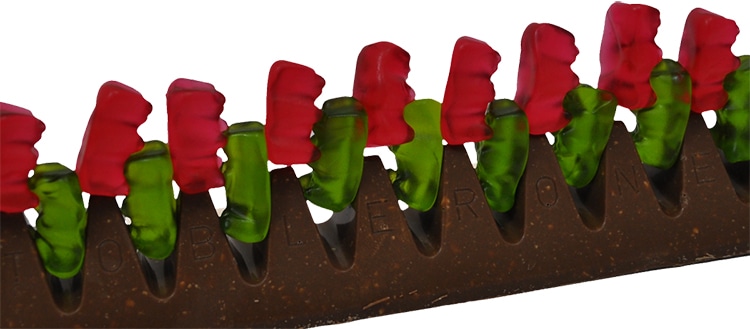Apr 17 2018
It is not easy to predict the behavior of electrons in a material. Physicists from the University of Geneva (UNIGE), ETH Zurich and EPFL substituted the electrons with ultra-cold neutral lithium atoms that they had circulated in a one-dimensional quantum tube. The researchers were then able to confirm a rare state of matter that preserves its insulation irrespective of the level of attraction between the particles. This research, published in PRX, paves the way to the search for new materials with atypical properties.
 In a one-dimensional periodic potential, represented here by a Toblerone bar, there is no flow of electrons (represented by Gummy bears) when two of them occupy a hollow space. The research made it possible to observe similar behavior with ultra-cold lithium-6 atoms. (Image credit: ETH Zurich)
In a one-dimensional periodic potential, represented here by a Toblerone bar, there is no flow of electrons (represented by Gummy bears) when two of them occupy a hollow space. The research made it possible to observe similar behavior with ultra-cold lithium-6 atoms. (Image credit: ETH Zurich)
The fact that a material is an insulator or a metal relies on a series of microscopic details, such as the presence of impurities or obstacles; the strength of the interactions between electrons; or the number of dimensions through which the charge carriers can spread. This high degree of complexity means that predicting the electronic properties of a particular material is a challenging task.
Knowing how to model the trajectory of a particle in a vacuum perfectly is not enough, as the researchers struggle to achieve the same thing in a material (a crystal for instance), where the electrons circulate between the nuclei of positively-charged atoms. The latter produces a periodic potential, similar to a series of peaks that influence the motion of the electrons, thus obscuring predictions. Will the material be an insulator? a metal? or a semiconductor? It will all rely on two parameters: the strength of the periodic potential and the strength of the interaction between the electrons.
The answer to these queries was found in the continuing discussions and debates between a group of theorists, led by Thierry Giamarchi, professor in the Department of Quantum Matter Physics (physics section) in UNIGE’s Faculty of Sciences, and the experimental groups based in Zurich and Lausanne, led by Martin Lebrat, from the group headed by Professor Tilman Esslinger at ETH Zurich’s Institute for Quantum Electronics; and by Jean-Philippe Brantut, Professor at EPFL.
The Coldest Place in the Universe
The researchers handled the issue by conducting their experiments on a flawlessly clean artificial material, meaning they could regulate the interaction and the periodic potential. Rather than circulating electrons whose long-range interactions make predictions tougher, the researchers used ultra-cold neutral lithium-6 atoms, which they stored using a laser in two borderless tanks, veritable “bowls of light”.
As Thierry Giamarchi explains - “The core of this experiment is the coldest place in the universe. The temperature there only reaches 70 billionths of a degree above absolute zero, which is much lower than in an interstellar vacuum.”
The atomic reservoirs were then linked by a one-dimensional quantum tube, in which a second laser was used to mimic the “peaks” of the periodic potential. The team was able to measure the conductivity of the tube while varying the applicable parameters, including the height and length of the periodic potential along with the interactions between the particles passing via it.
The researchers highlighted a rare state of matter, projected by the theory but which no one had been able to witness until then: a band insulator that is maintained irrespective of the strength of the attractive interaction between the particles. The natural conclusion was that the greater the attraction between the particles, the more probable it was that the material would be a conductor or superconductor.
It’s true. In a three-dimensional world but in the low-dimensional quantum world, it’s an urban legend. When you manage to confine the material in a one-dimensional quantum tube with a periodic potential, it remains insulating, even if there is an infinite attraction.
Professor Giamarchi
The massive flexibility resulting from this study opens the door for developing complex structures. “We can see this system as a kind of simulator that will define the ingredients to be used to devise a material that does not yet exist, and that could meet the requirements for future electronic systems – in quantum computers, for example,” says Giamarchi.